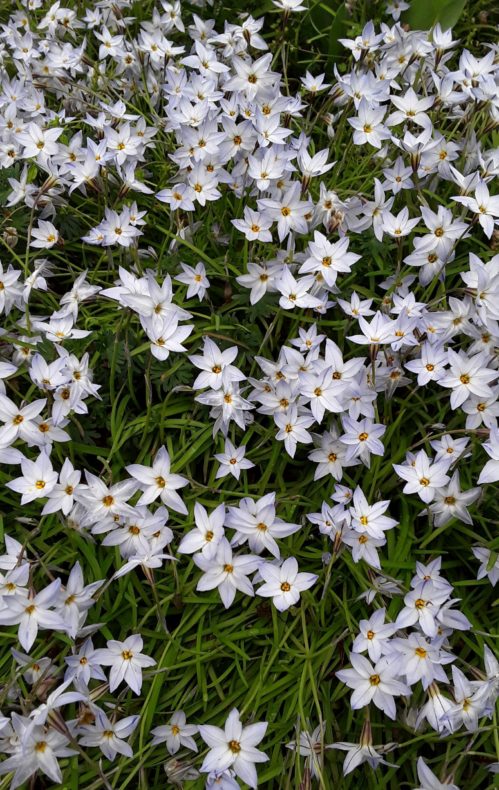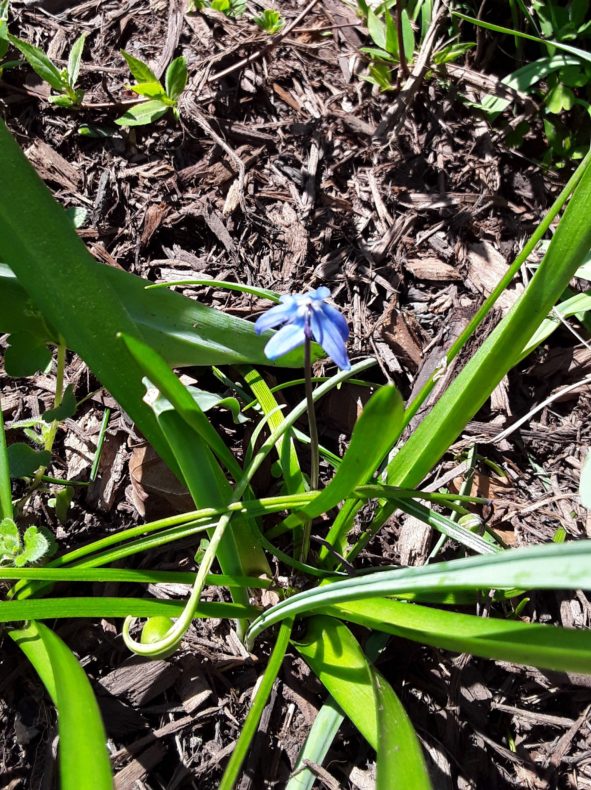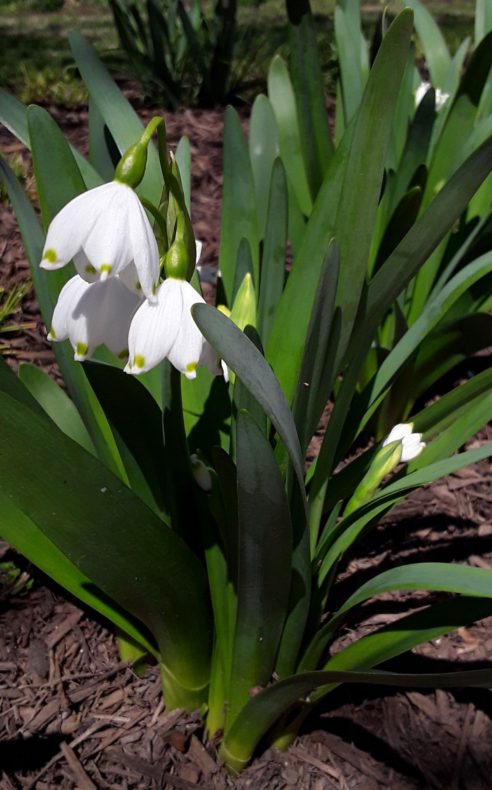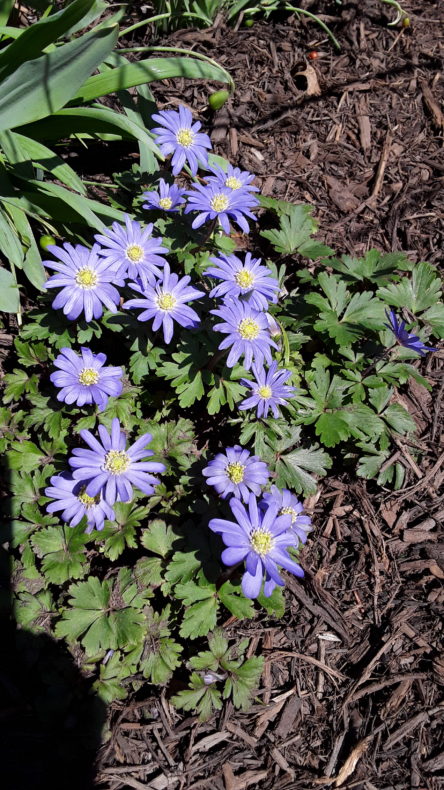
The repetition of this post, which first ran on April 5, 2021, and then again almost exactly a year ago, is out of my hands. I go outside for my morning walk, brooding on my bad habits; I look around the garden to see what’s not working now; and oh glory, oh sweet child of joy, the minor bulbs are blooming, they’re flourishing (“flourish,” from “florire,” to flower), they’re yelling all over the garden. How can I not?
And then, but then, I saw the Dutchman’s breeches. I planted them the fall before last, and that next spring, three of them leafed out but didn’t bloom. This spring, one BLOOMED, but two haven’t yet; and then in an entirely unrelated part of the garden, a fourth one BLOOMED. How graceful they are, how self-assured. When I was little, they used to grow wild in the woods, I loved them the way kids love unexpected beauty, and I haven’t seen them since. And here I believed that once something was gone out of your life, it wasn’t coming back. Silly you, say the Dutchman’s breeches.
§
The flowers that bloom in the spring tra la. I love them faintingly, I gaze at them, hands folded reverently, such dears they are, oh my darlings, my minor bulbs!
Minor bulbs might not be the same as spring ephemerals — that’s really their name — like spring beauties, dog-tooth violets, may apples, and shooting stars, their names alone are a song. Spring ephemerals grow in woods and each one is so delicate, so oh-please-stay-awhile that they break your heart when in the next minute they’re gone. I’ve tried transplanting them into my garden and it doesn’t work.

Neighbors and passers-by say how beautiful are the daffodils-narcissi-hyacinths, which I also love though more prosaically. Thank you, I say, but come look at my minor bulbs. Oh nice, say the neighbors and passers-by, and continue having transports over the major bulbs. But look at this one, I say, it’s called Chionodoxa, chion meaning glory and doxa meaning glory, snow glory, glory of the snow, see how the white centers fade into the blue petals, so interesting! The fact is, minor bulbs seem to be of no great interest to anyone but me.
For years I ignored them in the catalogs — minor, unworthy of my attention, and dirt cheap. The catalogs say to plant them in masses and drifts so you notice them. I don’t know about that: I’m kind of a minor bulb myself but I wouldn’t be better drifting all over the landscape.

The first one I planted was Ipheion uniflorum, this variety called Wisley blue, Wisley being a Victorian businessman who planted an experimental garden*. I can’t find out what Ipheion means (“Genus name origin is unclear,” says the Missouri Botanical Gardens) but the word looks Greek and if anyone knows I’d be so happy to hear it; uniflorum is one flower. So I planted maybe 5 of them so I could look at each one flower. But their character is such that they like their own company and they spread like water — I don’t know how because they’re bulbs — and now I have hundreds. I not only don’t know what Ipheion means, I can’t pronounce it so I call them Wisley blues. I step outside on a spring morning and yell, “Good morning, Wisley blues!” as loud as I can. This year, the Wisley blues might not be flourishing, to be honest, but maybe they’re just having an off year, maybe I haven’t yelled enough.

This little one is Scilla siberica, Siberian squill; a random internet source says scilla is Greek for exciting, which, hardly; the scillas/squills are a big family that includes lots of bluebell-like things. I planted this one inadvertently when I’d dug up, semi-legally, some huge naturalized snowdrops in a woods not obviously owned by anyone, and the little scilla came along. I’m not proud of my short career in piracy but I’m not giving this back. The scilla family spreads but this one hasn’t, just a few quiet, modest characters here and there, small but so intense and indigo you have to look at them. Such precision they have and so brave because early spring is not the kindest time of year. They’ve moved around over the years but are still sparce and in little bunches except at my neighbor’s house where they’ve grown into cities.

I saw this one in a catalog — it’s Leucojum aestivum, called ‘Gravetye Giant’ after an Irish garden writer whose house was Gravetye Manor. Leuco means white and I don’t know what jum has to do with it; aestivum is summer. Summer whites. I had trouble taking this picture because it was a little windy out and those heavy bells kept swinging back and forth. The little green dots could have been put there by some Arts & Crafts artist. Leucojum is much bigger than the other minor bulbs, a foot or so tall, dignified, very much a social presence. So while most of my minor bulbs are near the house where I can see their precision, leucojum is out by the sidewalk where it can be appreciated by people walking fast. If they walk too fast for appreciation, I intervene, I say come look at this flower. So far the people have been polite.

Anemone blanda, anemone is Greek for wind and like the leucojum, it blows around a bit; blanda is mild and pleasing; a mild wind flower. I tried planting these years ago and maybe they showed up once; tried again, no show, gave up. Read up on them, discovered that right after planting (shallow) they get eaten by squirrels. I was irate, felt disrespected, rose to the challenge, and ordered them again. Took advice: doubled-up old chicken wire, folded it into a tube, put the anemone tubers inside, stitched the tube together with wire, planted the whole thing, and watched hell-bent squirrel-holes appear in the mulch. They may have gotten some of them, I don’t know, but not all of them. NOT ALL OF THEM, YOU GREEDY BEADY-EYED RAT-BASTARDS! VICTORY IS MINE! This year, the anemones continue to look demure, charming, and squirrel-resistent.
Minor bulbs: prayer, pleasure, and righteous fury, at pennies per shot.
________
*In a comment on the original post, Adam Ganz says “Tiny point: Wisley is more than a minor businessman who planted a garden – it’s the research garden of the Royal Horticultural Society https://www.rhs.org.uk/gardens/wisley.”
________
Photos by me, and I wish they were better but that would mean getting an actual camera and learning to use it. Any reliable information has come from the website of the Missouri Botanical Gardens, an institution which is a gift unto us all.